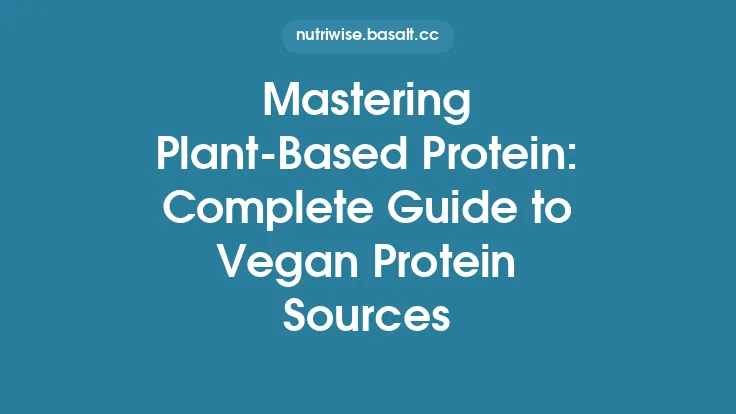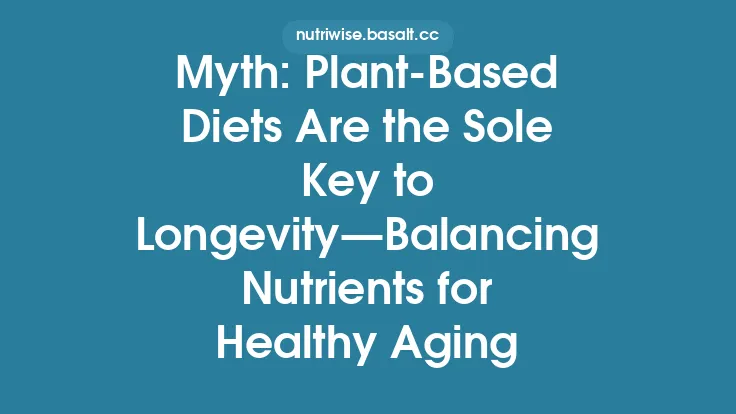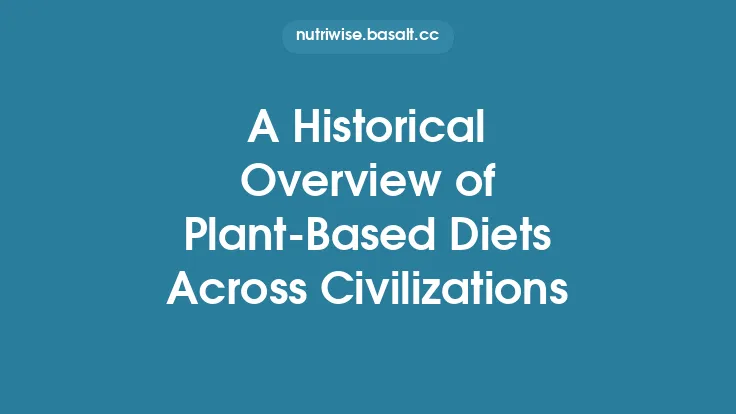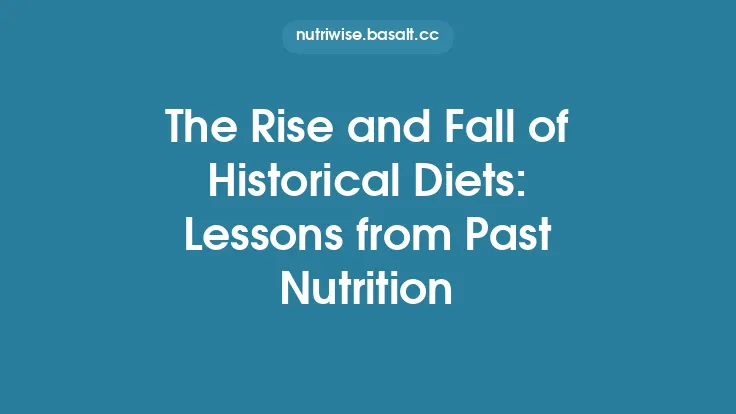The story of humanity’s relationship with protein is a tale of adaptation, innovation, and cultural transformation. From the earliest days when survival depended on the successful hunt of wild game, to the modern era where plant‑derived proteins dominate many diets, the sources of this essential macronutrient have continually shifted in response to ecological pressures, technological advances, and evolving societal values. Understanding these historical shifts provides insight not only into how we have met our nutritional needs over millennia, but also into the forces shaping today’s protein landscape.
The Paleolithic Protein Palette
During the Paleolithic era (roughly 2.5 million to 10 000 years ago), protein intake was dictated by the availability of wild fauna and flora within a given ecosystem. The primary protein sources included:
- Large ungulates – bison, elk, reindeer, and antelope provided high‑quality, complete proteins rich in essential amino acids.
- Small game and birds – rabbits, hares, pheasants, and waterfowl offered a more readily captured, though lower‑yield, protein source.
- Fish and marine mammals – coastal and riverine groups relied heavily on fish, seals, and sea turtles, which supplied not only protein but also omega‑3 fatty acids crucial for brain development.
- Invertebrates – insects, crustaceans, and mollusks were opportunistically harvested, especially in regions where larger game was scarce.
The protein quality of these sources was generally high, with a balanced profile of essential amino acids. Moreover, the consumption of organ meats (liver, kidney, heart) added micronutrients such as iron, zinc, and vitamin B12, which are less abundant in plant foods.
The Neolithic Transition: Domestication and Early Livestock
The advent of agriculture around 10 000 years ago did not immediately diminish reliance on wild protein, but it introduced a new, more controllable source: domesticated animals. The earliest domesticated species—sheep, goats, and later cattle and pigs—were initially valued for secondary products (milk, wool, traction) but quickly became central protein providers.
- Sheep and goats offered both meat and milk, allowing for a diversified protein intake.
- Cattle provided large quantities of meat, and their ability to convert low‑quality forage into high‑quality protein made them especially valuable in mixed farming systems.
- Pigs thrived on kitchen waste and forest foraging, making them efficient converters of otherwise unusable biomass into protein.
These animals also facilitated the development of protein storage strategies, such as drying, smoking, and salting, which extended the shelf life of meat and allowed for seasonal surpluses. While these methods intersect with food preservation, the focus here is on how they enabled a more reliable protein supply rather than the technicalities of preservation itself.
The Rise of Aquaculture and Fishery Intensification
Parallel to terrestrial animal domestication, human societies refined their exploitation of aquatic resources. Early fish traps, weirs, and netting techniques evolved into more sophisticated fisheries, and by the Classical period (c. 500 BC–500 AD) certain cultures had begun rudimentary forms of aquaculture:
- Pond culture of carp in East Asia allowed for controlled breeding and harvesting cycles.
- Shellfish beds were managed through selective harvesting, ensuring sustainable yields.
These practices increased the proportion of protein derived from aquatic sources, especially in regions where land for livestock was limited. Fish remains a complete protein source, and its lower fat content (relative to many terrestrial meats) contributed to dietary diversity.
The Medieval and Early Modern Era: Diversification of Protein Sources
During the medieval period, protein consumption patterns diverged significantly across social strata and geographic regions:
- Nobility often consumed large quantities of meat, including game (deer, boar) and exotic imports (camel, ostrich) facilitated by expanding trade networks.
- Peasantry relied more heavily on legumes (beans, lentils, peas) and cereals for protein, supplementing limited meat consumption. While legumes are not complete proteins on their own, they provide essential amino acids when combined with grains—a practice that became a dietary staple.
- Insect consumption persisted in certain cultures (e.g., locusts in the Middle East, beetles in parts of Africa), offering a high‑protein, low‑environmental‑impact food source.
The early modern period saw the introduction of new world crops (e.g., soybeans, peanuts) to Europe, Asia, and Africa. Soy, in particular, became a cornerstone of protein in East Asian cuisines, thanks to its versatility (tofu, tempeh, soy milk) and high protein density.
The Industrial Revolution: Scaling Animal Protein Production
The 18th and 19th centuries ushered in mechanization and scientific breeding, dramatically reshaping protein supply:
- Selective breeding produced livestock with faster growth rates and higher meat yields (e.g., the development of the modern broiler chicken).
- Concentrated animal feeding operations (CAFOs) allowed for the mass production of meat, dairy, and eggs, reducing per‑unit costs and making animal protein more accessible to urban populations.
- Synthetic fertilizers boosted the productivity of feed crops (corn, soy), creating a feedback loop that further amplified animal protein output.
These advances increased the proportion of dietary protein derived from animal sources, especially in industrialized nations, and contributed to a global shift toward higher meat consumption per capita.
The 20th Century: Emergence of Alternative Protein Technologies
Mid‑20th‑century scientific breakthroughs laid the groundwork for modern protein alternatives:
- Protein isolates: Techniques such as isoelectric precipitation enabled the extraction of concentrated protein from soy, whey, and later pea sources. These isolates became ingredients in processed foods, sports nutrition, and infant formulas.
- Textured vegetable protein (TVP): Developed in the 1960s, TVP mimics the fibrous texture of meat, facilitating the creation of meat analogues that could be seasoned and cooked similarly to ground beef.
- Fermentation‑derived proteins: The discovery that certain microorganisms could produce single‑cell proteins (e.g., from *Candida or Spirulina*) opened avenues for protein production independent of traditional agriculture.
While these technologies intersect with food processing, the emphasis here is on how they expanded the repertoire of protein sources beyond conventional animal and plant foods.
The 21st Century: Plant‑Based and Cultivated Proteins
In recent decades, a confluence of health, environmental, and ethical concerns has accelerated the transition toward plant‑based and cultivated proteins.
Plant‑Based Meat Alternatives
Companies have refined extrusion and shear‑cell technologies to create plant‑based products that closely replicate the taste, texture, and juiciness of animal meat. Key ingredients include:
- Pea protein – high in lysine, a limiting amino acid in many plant proteins.
- Rice protein – hypoallergenic and easily digestible.
- Faba bean protein – rich in iron and fiber.
These products often incorporate fat mimetics (e.g., coconut oil, sunflower oil) and natural flavor compounds to achieve sensory parity with meat.
Cultivated (Cell‑Based) Meat
Cultivated meat involves in vitro growth of animal cells within a bioreactor, using a nutrient‑rich medium to support proliferation and differentiation. While still emerging, this technology promises:
- Reduced land and water footprints compared to conventional livestock.
- Elimination of animal slaughter, addressing ethical concerns.
- Potential for precise nutrient tailoring, such as adjusting fatty acid profiles.
Research continues to optimize scaffold materials, growth factors, and scaling processes to make cultivated meat commercially viable.
Insect Protein Commercialization
Modern processing methods have enabled the mass production of insect powders (e.g., from crickets, mealworms) that can be incorporated into protein bars, snacks, and bakery products. Insects offer:
- High protein efficiency ratio (PER) – a measure of protein quality.
- Low greenhouse gas emissions relative to cattle and pork.
- Rapid life cycles, allowing for quick turnover and minimal resource input.
Legume and Pulse Innovation
Advances in plant breeding and genomics have produced high‑yield, disease‑resistant varieties of beans, lentils, and peas. Coupled with improved processing (e.g., de‑hulling, sprouting), these pulses now serve as primary protein sources in many plant‑forward diets.
Socio‑Cultural Drivers of Protein Shifts
Beyond technological factors, cultural dynamics have profoundly influenced protein consumption patterns:
- Religious dietary laws (e.g., halal, kosher, vegetarianism in Hinduism and Buddhism) have historically dictated permissible protein sources, fostering the development of alternative foods.
- Health movements (e.g., the rise of low‑fat, high‑protein diets in the 1970s; the modern “flexitarian” trend) have prompted consumers to seek leaner or plant‑based proteins.
- Environmental awareness—particularly concerns about climate change and biodiversity loss—has spurred policy initiatives and consumer preferences favoring lower‑impact protein options.
These forces interact with economic accessibility, creating a feedback loop that accelerates the adoption of novel protein sources.
Nutritional Considerations Across Protein Sources
When evaluating historical and contemporary protein sources, several nutritional dimensions merit attention:
| Source | Complete Protein? | Key Micronutrients | Typical Digestibility (PDCAAS) |
|---|---|---|---|
| Wild game (e.g., elk) | Yes | Iron, zinc, B12 | 0.90–1.00 |
| Domesticated livestock (beef, pork, poultry) | Yes | B12, iron, zinc, selenium | 0.90–1.00 |
| Fish & marine mammals | Yes | Omega‑3 (EPA/DHA), iodine, B12 | 0.90–1.00 |
| Insects (crickets, mealworms) | Yes | Iron, calcium, B12 (variable) | 0.70–0.85 |
| Soy (tofu, tempeh) | Yes (when fermented) | Calcium, iron, isoflavones | 0.91 |
| Pea protein isolate | Yes (supplemented) | Lysine, iron | 0.80–0.85 |
| Legumes (beans, lentils) | Incomplete (low methionine) | Folate, iron, fiber | 0.70–0.80 |
| Cultivated meat | Yes (engineered) | Comparable to conventional meat | Target >0.90 (ongoing) |
Understanding these profiles helps explain why certain societies gravitated toward specific proteins and why modern nutrition science emphasizes diversity and complementarity (e.g., pairing legumes with grains to achieve a complete amino acid profile).
Environmental Implications of Protein Evolution
The shift from wild hunting to intensive animal agriculture dramatically increased the ecological footprint of protein production:
- Land use: Livestock grazing and feed crop cultivation now occupy roughly 30 % of global terrestrial land.
- Water consumption: Producing 1 kg of beef can require up to 15 000 L of water, whereas 1 kg of soy protein may need less than 2 000 L.
- Greenhouse gas emissions: Ruminant livestock contribute ~14.5 % of anthropogenic methane, a potent greenhouse gas.
Conversely, plant‑based and insect proteins generally demand fewer resources per gram of protein, positioning them as key components of sustainable food systems. Cultivated meat, while still energy‑intensive, holds the promise of further reducing land and water use if renewable energy sources are employed.
Future Trajectories: Integrating Tradition and Innovation
Looking ahead, the evolution of protein sources is likely to be characterized by a pluralistic approach that blends time‑tested practices with cutting‑edge technologies:
- Hybrid diets that combine modest amounts of animal protein with abundant plant‑based proteins, optimizing health outcomes while curbing environmental impact.
- Regional revitalization of traditional protein sources (e.g., indigenous fishery practices, heritage legumes) to preserve cultural heritage and enhance food security.
- Precision nutrition leveraging genomics and metabolomics to tailor protein intake to individual metabolic needs, potentially guiding the selection of specific protein types.
- Circular bioeconomy models that valorize by‑products (e.g., using spent grain from brewing as a protein‑rich feed) and integrate waste streams into protein production.
These pathways underscore that the story of protein is not a linear march from “primitive” to “modern,” but a dynamic interplay of ecological constraints, cultural values, and scientific ingenuity.
Concluding Reflections
From the raw, nutrient‑dense flesh of hunted megafauna to the sophisticated, plant‑derived proteins that line supermarket shelves today, humanity’s protein sources have continually adapted to the challenges and opportunities of each epoch. Each transition—whether driven by climate fluctuations, domestication breakthroughs, industrial scaling, or contemporary sustainability concerns—has left an indelible imprint on dietary patterns, health outcomes, and the planet’s ecological balance.
By tracing these historical shifts, we gain a richer appreciation for the diversity of protein foods that have sustained societies across time, and we equip ourselves with the perspective needed to navigate the complex protein landscape of the future. The ongoing dialogue between tradition and innovation will shape not only what we eat, but also how we define nourishment in an increasingly interconnected world.





